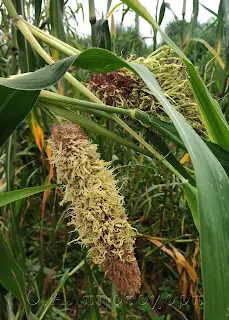Green ear disease of bajra
Downy mildew of pearl millet
Host: Pennisetum typhoides (Burm.) Stapf & Hubb.
Pathogen: Sclerospora graminicola (Sacc.) Schroet.
Pathogen: Sclerospora graminicola (Sacc.) Schroet.
Distribution of disease
Green ear disease is the most destructive disease of bajra
and widely distributed throughout tropical and temperate countries of the world.
The disease has been reported from the countries including India, Iran, Israel,
China, Fiji, Japan and the countries wherever Bajra crop is grown. In India,
the disease was first reported Butler (1907). Mitter and Tandon (1930) reported
the disease from Allahabad, Uttar Pradesh. In India, the disease appeared as
epidemic in Karnataka and Maharashtra during 1975 and caused heavy loss in crop
yield.
Symptoms
 |
| Pearl millet showing partial green ear |
 |
| Ear-head showing complete phyllody |
Symptoms of the disease appear as a result of systemic
infection. Symptoms of downy mildew appears on the leaf and green ear appears in
the inflorescence.
Leaf symptoms begin as chlorosis (yellowing) at the base of the leaf lamina, and successively top leaves show greater leaf coverage by symptoms.
When ear-head is infected, the floral part converted into leafy appendages because of the hypertrophy, which is called as green ear or phyllody. The infection in the head may be partial or complete.
Leaf symptoms begin as chlorosis (yellowing) at the base of the leaf lamina, and successively top leaves show greater leaf coverage by symptoms.
When ear-head is infected, the floral part converted into leafy appendages because of the hypertrophy, which is called as green ear or phyllody. The infection in the head may be partial or complete.
Control measures
The disease primarily is soil borne, which can be controlled
by methods.
- Crop rotation with non-host plants reduce the disease.
- Treatment of seed with 0.1 % Agrosan GN and 0.4 % Thiram control the disease up to 50 %.
- Spraying with Dithane M-45 reduces the disease infection.
- Diseased plants and debris should be burned.
- Cultivation of resistant varieties like HB-15, PHB-10 and PHB-14 should be practiced.
Content first created on 05-05-2021
last updated on 05-05-2021
last updated on 05-05-2021





0 Comments
Leave your comments here.